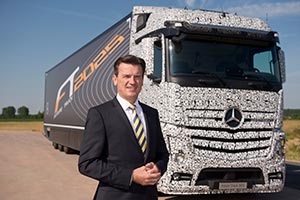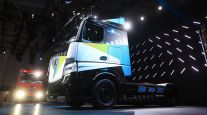Daimler Demonstrates Self-Driving Truck, Says Technology Will Change Profession

This story appears in the July 14 print edition of Transport Topics.
MAGDEBURG, Germany — Daimler Trucks this month premiered its latest technological innovation, an autonomous-driving truck the company believes will reshape the truck-driving profession.
Daimler said its Mercedes-Benz Future Truck 2025 uses an assistance package called Highway Pilot to allow truckers to turn their attention away from active driving and do other tasks from the driver’s seat or simply relax while the tractor-trailer maneuvers itself over long highway stretches at a top speed of nearly 53 mph.
“Today, we are writing a new chapter in truck history,” said Wolfgang Bernhard, head of Daimler’s global truck and bus unit. “The vision of autonomous driving is becoming a reality.”
At a July 3 event here, which included European government officials and more than 300 journalists from around the globe, Daimler demonstrated the autonomous-driving truck on a closed-off stretch of the autobahn.
PHOTO GALLERY: Images from Daimler demo.
With obstacles such as a fast-moving police vehicle and a disabled vehicle on the side of the road, the Future Truck made speed and lane adjustments while traveling alongside more than a dozen other vehicles. As all of this was happening, the trucker sat passively in his seat, at one point waving to a camera in the cab.
In other demonstrations, the truck warned the driver to retake full control of the vehicle. It is programmed to slow and pull to the side of the road if the command is ignored.
Daimler officials said the company aims to make the truck commercially viable by 2025, provided the required regulatory changes, public acceptance and infrastructure development occur.
“Autonomous driving is on its way,” said Sven Ennerst, head of Daimler’s truck product engineering and global procurement. “Machines don’t get tired; they don’t have a bad day.”
The technology relies on vehicle-to-vehicle and vehicle-to-infrastructure communications as well as a series of sensors and cameras to monitor road conditions. It also has safeguards built in to ensure the driver remains in the seat and does not fall asleep.
Ennerst, like other Daimler executives, stressed that Highway Pilot is not meant to replace drivers but instead will relieve them from the monotony of long highway driving stretches. He said it is different from Google’s “driverless” car technology or “caravans” that have been tested by truck manufacturers including Volvo and Scania.
Volvo Trucks participated in a European Union project called Safe Road Trains for the Environment that aimed at “discovering the possibilities with vehicle platoons on public highways,” according to the project’s website. Known as SARTRE, the project ran from 2009 to 2012.
Scania is participating in a three-year EU project on truck platooning, launched in 2013.
WHAT DO YOU THINK? Tell us on Facebook.
The Future Truck is an extension of Mercedes’ test last year of an autonomous S-Class passenger vehicle through about 60 miles of streets in Germany. Bernhard headed the Mercedes car unit until April 2013, when he moved over to the truck side.
Seeking to build support for the technology, Daimler executives noted a high percentage of highway accidents are due to human error, and the autonomous-driving system can react to dangerous situations faster than humans can or provide additional warning time of what lies ahead. Fuel consumption and emissions benefits were also touted.
Daimler positioned Future Truck as a turning point in the driver shortage, a growing problem in many parts of the world.
Executives crafted a vision of a driver morphing into a hands-on “logistics manager,” conducting real-time business on a computer during stretches while the truck is operating on its own. The driver’s seat of the cab can shift 45 degrees to the right, providing additional comfort and space.
During the live demo, a driver was shown securing a parking spot at a nearby truck stop and ordering a meal on his tablet as the truck navigated driving sequences. The implication was that Future Truck makes truck driving easier and a more attractive career path.
“By showing how this works, we can take away fears,” Bernhard said.
Company officials declined to discuss cost estimates for Future Truck but said a more formal introduction of Future Truck will take place at the IAA (International Automobile-Ausstellung) truck show later this year in Hanover, Germany.
Besides showcasing the truck’s capabilities, Daimler used the event to draw attention to the hurdles that must be overcome before Future Truck reaches its full reality.
Bernhard said that, in Europe, recent changes to the United Nations’ Vienna Convention on Road Conditions have eased the path for the European Union and individual nations to create a framework to encourage the growth of autonomous-driving vehicles.
He warned that because the United States never signed that agreement, it has given firms such as Google a leg up, because several states have approved some use of autonomous vehicles.
There are not, however, any U.S. federal regulations in place for interstate driving of autonomous vehicles.
Data privacy, liability concerns, vehicle registration rules and the need for further development of a “smart” traffic system so highways and vehicles can communicate were among the long list of other potential obstacles discussed during the event.
Among those lending support were Katherina Reiche, a member of the German Federal Ministry of Transport, who said “automated systems are the future.”
She also warned that “this does not mean more automation goes hand in hand with more time on the road. This does not mean less rest time.”




